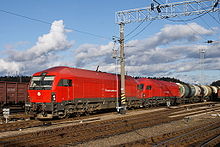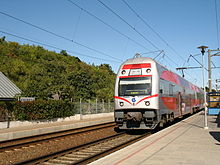Lietuvos Gelezinkeliai
| AB "Lietuvos Gelezinkeliai"
|
|
|---|---|
| legal form | Akcinė bendrovė |
| founding | December 24, 1991 |
| Seat |
Vilnius Lithuania |
| management | Stasys Dailydka (General Director) |
| Number of employees | 10.150 |
| sales | 429 million euros |
| Branch | Transport and logistics |
| Website | www.litrail.lt |
| Status: 2015 | |
Lietuvos ležinkeliai ( , abbreviation LG or since 2020 LTG ) is a state-owned company and the largest railway company in Lithuania . LTG is based in Vilnius . The state-owned company SPAB Lietuvos Gelezinkeliai was registered on December 24, 1991. In 2012, the company achieved sales of 1.727 billion litas . During the period of Lithuania's first independence, a predecessor company existed under the same name from 1918 to 1940 .
Traffic significance

Today, LTG is of great importance in the transit of goods and is declining (in favor of individual transport and intercity buses ) in passenger transport in the country. Nowadays, LTG is increasingly using diesel and electric multiple units for passenger transport (in contrast to the trains that used to be hauled by locomotives). The main focus of the wide-meshed railway network is the southeast of the country. International trains and trains to the coast to Klaipeda are mostly driven by diesel locomotives .
There is a S-Bahn -like system of suburban trains around Vilnius and Kaunas . International connections now exist again to all neighboring countries, albeit in some cases severely limited (e.g. to Poland only on weekends). Since June 2016 there are direct train connections from Poland to Lithuania ( Białystok - Kaunas ) on weekends ; there is no need to change trains in Šeštokai , as the route has been switched to standard gauge. In addition, Lithuania is an important transit country for traffic from Russia via Belarus ( Minsk ) to Kaliningrad . The connection from Grodno / Hrodna to Vilnius, however, was cut at the state border. The transit of goods is also important. Klaipėda is an important oil port , most of which is supplied by LTG.
Transport performance
The transport performance of LG in freight transport was 50 million tons in 2004, 53.5 million tons in 2007, of which 38% was accounted for by transit traffic between Russia and the Kaliningrad Oblast . The share in the total freight traffic could be increased from 33% to 44% in the same period. In contrast, the market share in passenger transport in the two years was only around 2%, which is divided between around 1 million passengers in long-distance transport and 6 million in local transport.
In 2015, 14.4 million t of local goods, 20.61 million t of imports, 4.09 million t of exports and 8.92 million t of transit goods were transported.
Traction vehicles

When the LG was re-established in 1991, the fleet of locomotives consisted primarily of vehicles manufactured by the Soviet Union, with shunting locomotives from Czechoslovakia and Hungarian diesel railcars added. Since around 2000, LG began to renew its fleet of traction vehicles through new purchases and modernizations.
In summer 2005, LG placed an order with Siemens Transportation Systems 34 new six-axle diesel-electric locomotives on the euro Runner-2007 platform, Type ER 20 CF based. LTG took over the Siemens type designation as the series designation. The transfer of the first locomotive of the new LG ER20 series to Lithuania took place in early October 2007. An option for a further ten machines was also exercised; they were delivered in 2010. So far, the locomotives have only been used in freight traffic, on a trial basis also in front of express trains. In addition to the new purchases, a large number of older locomotives of Czech and Soviet production were modernized with new engines and in some cases provided with new superstructures.
LTG procured various new railcars for passenger transport. In 1997, the Rigaer Waggonfabrik delivered a class AR2 diesel multiple unit. In 2008, the LG received from Škoda two railcars corresponding to the ČD series 471 , designated series 575, for traffic between Vilnius and Kaunas. In the following years, more railcars of this series were delivered; as of November 2017, LG had a total of 13 of these double-decker railcars. In addition to the important route between Vilnius and Kaunas, they are also used in cross-border traffic to Minsk . In 2008, four diesel multiple units from the Russian manufacturer Metrowagonmasch were procured as the 750.05 series. Two diesel railcars from PESA , known as the 620 series in Poland, followed in 2009, and a further eight railcars were ordered from PESA in 2010.
Web links
- Litrail (Lithuanian, English, Russian)
- Timetable information (Lithuanian, English, Russian)
swell
- Herman Gjisbert Hesselink, Norbert Tempel: Railways in the Baltic States. Lok-Report publishing house, Münster 1996, ISBN 3-921980-51-8 .
- Claus Strunden: Lithuania in the summer of 2009. In: Lok-Report . 11, 2009, pp. 44-51.
literature
- Klaus Mölter: Lithuania's Railway of the Present. Link .
- Baltic Railways Magazine. Issues 1 and 2 only Lithuanian / Russian, from volume 3 Lithuanian / English, link .
Individual evidence
- ↑ a b c Annual Report 2015
- ↑ Register data ( Memento of the original from April 2, 2015 in the Internet Archive ) Info: The archive link was inserted automatically and has not yet been checked. Please check the original and archive link according to the instructions and then remove this notice.
- ↑ Sales ( memento of the original from January 15, 2014 in the Internet Archive ) Info: The archive link was automatically inserted and not yet checked. Please check the original and archive link according to the instructions and then remove this notice.
- ↑ Statistics ( Memento of the original from August 8, 2014 in the Internet Archive ) Info: The archive link was inserted automatically and has not yet been checked. Please check the original and archive link according to the instructions and then remove this notice.
- ↑ www.newstix.de: The last double-decker set from Škoda Vagonka arrived in Lithuania , November 5, 2017 , accessed on November 6, 2017
- ↑ Announcement in the EU Official Journal (no longer available)
